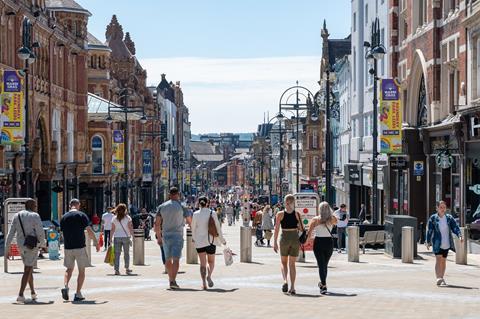The commission will look at how we can overcome systemic challenges in order to create thriving communities

When it comes to building the sustainable and desirable new communities that people actually want to live in, it often feels as if Britain is stuck in an intractable mess of its own making. Housing is costly and supply consistently fails to meet demand. Transport infrastructure and access to work are all too often treated as afterthoughts. And the quality of design and construction in housing and community buildings remains poor.
It can be tempting to give up in despair, but if best practice can be identified from across the UK and overseas then we can change the narrative. But achieving that change requires facing up to the systemic challenges and driving a cultural shift in how we deliver new development.
Levelling up
There is a widespread political consensus that the country needs to address the disparities between its poorest and wealthiest regions. But how best to achieve this objective? The government had made levelling up a central plank of its agenda, but covid and the cost of living crisis have only exacerbated the economic divide.
Can the built environment help level up the poorest parts of the country? Attractive towns and cities help instil pride and draw in investment. But who decides what鈥檚 beautiful and how do we get developers, architects and planners to pull together to deliver the type of built environment that people want?
Placemaking
For decades the UK has been struggling to find the mix of skills, incentives, and regulatory framework to help ensure that new developments are high quality and sustainable. But the quality of the new places we build is still often poor.
One influential view is that architects and planners simply lack the training to design and create successful communities. The theory goes that architecture schools teach students to conceive of buildings as objects in space, rather than as interconnected elements within an urban tapestry that have a vital public realm and social dimension.
Planners are perhaps also ill-equipped. Their role has been reduced to that of a development control function, with limited levers available to direct development or ensure quality.
One consequence of so much poor urban design is a lot of local resistance to new development in many parts of the country. This in itself holds up the creation of new communities and adds to the cost of development due to lengthy planning processes that often include appeals.
The government is introducing a statutory requirement for local design codes, which planners should be able to use to help influence the quality of development produced by developers and their architects
Should we move towards a system in which local communities and planners have more scope to direct where development goes? And should we develop a system where planning guidelines stipulate more clearly what is expected from developers in terms of design quality, thereby helping reduce uncertainty and delay?
The government is introducing a statutory requirement for local design codes, which planners should be able to use to help influence the quality of development produced by developers and their architects. Making such a system democratically accountable and seen to be serving the public good will be a key measure of its success.
More widespread use of a design review panel system, perhaps with an element of compulsory gateways, might also help drive up the standard of new development.
The question of whether the answer lies in more legislation and regulation, or simply better application of existing powers and the available skills, is one that we hope to address in more detail over the coming year.
Greenfield development
Despite a growth in brownfield redevelopment, huge amounts of new housing and commercial development are still built on the edges of villages, towns and cities.
Due to the UK鈥檚 history of underinvestment in public transport infrastructure, and a poor record in supporting walking and cycling, many of these developments are inevitably heavily car-dependant, exacerbating problems with traffic, pollution and poor health and wellbeing.
We need to find new ways to better integrate edge of town development into public transport systems and with walking and cycling routes. New thinking in terms of urban design can help turn car-centric edge of town developments into healthy places to live and work.
Heritage-led regeneration and retrofit
One of the UK鈥檚 biggest placemaking assets is its huge stock of historic buildings. But too often developers鈥� first response to an old building is to knock it down. The growing need to consider retrofit as an option is changing attitudes. But we also need to recognise the intrinsic economic and cultural benefits accrued through conserving beautiful old buildings that convey a sense of place and history, especially when incorporated into new developments.
>> Click here for more on the 好色先生TV the Future Commission
Conservation can go hand in hand with energy efficiency and the creation of thriving communities. We can also begin restitching our damaged historic townscapes by intelligent and sensitive new insertions that respect existing streetlines and reinforce the existing grain and character of a place.
Urban densification
Although the UK has long been one of the most urbanised countries in the world, we have an ambiguous relationship with our cities. Instead of creating urban neighbourhoods with flats, townhouses, and urban squares, we have chosen to build low density suburbs. These are usually places where we rely on the car to get around because the low densities make public transport uneconomic.
Could we densify the swathes of generic early 20th century suburbia that blanket large parts of our urban areas? Doing so would reduce the need for more greenfield development, and help create the critical mass of people that facilitates good public transport networks and the thriving economic clusters that drive innovation and growth. Street votes are one idea to help deliver greater density in the suburbs.
Regenerating our towns and cities
The late Richard Rogers helped initiate a new wave of urban regeneration in the UK during the late 1990s and early 2000s. Drawing on the European model of liveable and late-night urban centres, he and many others in construction and design, saw the potential to reimagine the often-tired regional cities that had emerged from the UK鈥檚 deindustrialisation and some misguided post-war planning.

The focus during that period was on city centre living (often in small one- and two-bed apartments), culture, leisure and retail. But family homes, parks and community facilities were often left out, leaving many city centres feeling overly commercialised.
With traditional retail struggling and fewer people travelling to their office to work, there is an opportunity to reimagine city centres as family and community focused spaces
With traditional retail struggling and fewer people travelling to their office to work, there is an opportunity to reimagine city centres as family and community focused spaces with a more diverse range of uses. Could our city centres rise again as hubs for reinvigorated regional democracy and civic life?
Sustainability the biodiversity
The UK is one of the most biodiversity-depleted countries in the world. But by making our built environments greener and smarter, we can facilitate better quality new habitats for plants and animals, even in densely populated urban areas.
Sustainability, and increasingly climate adaptation, needs to be at the core of thinking about the built environment. Greener communities with good public transport and access to green spaces help drive wellbeing and investment.
Transport
The car is not going to go away anytime soon. But we can create communities that facilitate more walking, cycling and public transport use. Electric scooters and other new personal transport innovations are driving a revolution in micro mobility that makes getting around greener and healthier.
Walkable and tree lined streets help reduce traffic speeds and encourage pedestrians to leave the car at home and walk to the shops, school or work. We need to think of transport holistically and strategically to deliver a better and healthier built environment.
Land ownership and compulsory purchase reform
The way in which land is owned and controlled in the UK underlies many of the key challenges that prevent us delivering more and better-quality development, particularly of housing. Developer clients and their consultant teams must grapple with extremely high land values and a system that enables much of the value in land to be extracted before a single foundation has been laid.
There has been much criticism from some quarters of perceived land banking and the practice of selling on land once planning has been achieved, which means that developers are often incentivised to get outline planning and sell on. As Michael Gove has observed: 鈥淢any of the large housebuilders are land investment speculators, not really housebuilders.鈥� Once a scheme actually gets to site, investment in public realm, energy efficiency and shared amenities are then often cost engineered out in order to ensure commercial viability.
Publicly owned land could provide one solution, either by being developed directly by the public sector, or sold at below market rates with legal guarantees to deliver higher quality development. But where such land is available for housing development, government policy requires that it must be sold on at maximum market value, simply perpetuating the problem of the high cost of land squeezing out quality.
The UK needs to reassess how it uses the precious resource of land to deliver more public goods in balance with private profit. Part of the solution may involve looking again at compulsory purchase powers and how these can be used to fairly compensate landowners in a way that doesn鈥檛 exagerate the land鈥檚 value.
好色先生TV the Future Commission

The 好色先生TV the Future Commission is a year-long project, launched to mark 好色先生TV鈥檚 180th anniversary, to assess potential solutions and radical new ways of thinking to improve the built environment.
The major project鈥檚 work will be guided by a panel of 19 major figures who have signed up to help guide the commission鈥檚 work culminatuing culminate in a report published at the end of the year.
The final line-up of commissioners includes figures from the world of contracting, housing development, architecture, policy-making, skills, design, place-making, infrastructure, consultancy and legal.
The commissioners include Lord Kerslake, former head of the civil service, Katy Dowding, executive vice president at Skanska, Richard Steer, chair of Gleeds, Lara Oyedele, president of the Chartered Institute of Housing, Mark Wild, former boss of Crossrail and chief executive of SGN and Simon Tolson, senior partner at Fenwick Elliott. See the full list here.
The project is looking at proposals for change in eight areas:
- Education and skills
- Housing and planning
- Infrastructure
- 好色先生TV safety
- Project delivery and digital
- Workplace culture and leadership
- Creating communities
>> Editor鈥檚 view: And now for something completely positive - our 好色先生TV the Future Commission
>> Click here for more about the project and the commissioners
好色先生TV the Future will also undertake a countrywide tour of roundtable discussions with experts around the regions as part of a consultation programme in partnership with the regional arms of industry body Constructing Excellence. It will also set up a young person鈥檚 advisory panel.
We will also be setting up an ideas hub and we want to hear your views.
>> Email buildingfuturecommission@building.co.uk to get in touch



























No comments yet